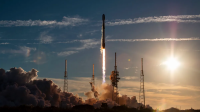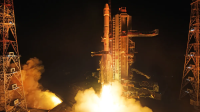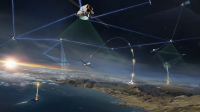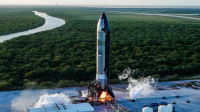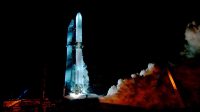SpaceX successfully launched a classified mission for the U.S. military on February 14, deploying six missile-detection satellites into orbit. The mission, known as USSF-124, saw the Falcon 9 rocket carrying payloads for both the Missile Defense Agency and the Space Development Agency.
Taking off from Launch Complex 40 at Cape Canaveral Space Force Station in Florida at 5:30 p.m. Eastern time, the rocket placed the six satellites into low Earth orbit. The payload comprised five satellites manufactured by L3Harris Technologies and one by Northrop Grumman.
Following liftoff, the first stage of the Falcon 9 landed back at Landing Zone 2 at Cape Canaveral Space Force Station. However, at the government's request, SpaceX discontinued the webcast after the landing and refrained from showing images of the payload.
USSF-124 marked SpaceX's 11th mission under the National Security Space Launch program and the second under the NSSL Phase 2 contract. Two of the satellites onboard, one from L3Harris and the other from Northrop Grumman, serve as prototypes under the Missile Defense Agency's Hypersonic and Ballistic Tracking Space Sensor (HBTSS) program.
The remaining four L3Harris satellites form part of the Space Development Agency's Tracking Layer Tranche 0. These demonstration satellites will contribute to the testing of a large constellation aimed at global indications, warning, tracking, and targeting of missile threats.
Both the Missile Defense Agency and the Space Development Agency are collaborating to develop a sensor network for tracking hypersonic and ballistic missiles. The successful deployment of all six satellites was confirmed by the Space Systems Command.
According to SDA, the satellites will operate together in a near equatorial orbit to conduct demonstrations. SDA Director Derek Tournear emphasized the importance of launching tracking satellites into the same orbit as MDA's HBTSS satellites to facilitate joint observations.
The satellites deployed by SDA feature wide-field-of-view sensors designed to detect missile launches, while MDA's payloads offer detailed tracking data crucial for intercepting hypersonic threats accurately.
For L3Harris, this mission represents a significant achievement, marking its first prime contract in the missile defense sector. The company utilized decades of experience in infrared imaging technology, previously applied in weather imaging and Earth science missions, to develop the satellites.
Kelle Wendling, president of space systems at L3Harris, highlighted the company's substantial backlog of satellite orders, including those for SDA's Tracking Layer Tranches 1 and 2.


